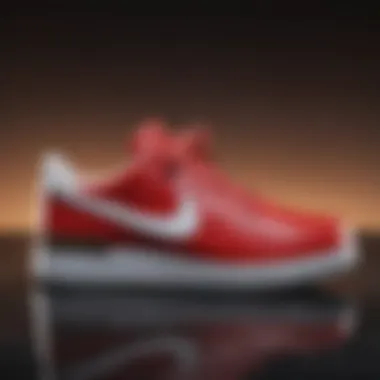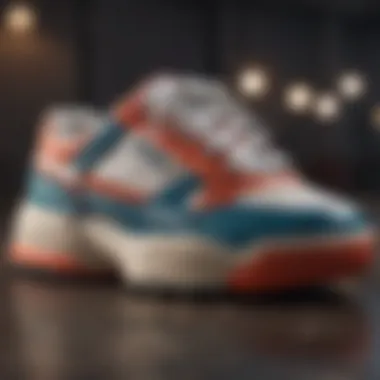Top Designer Sneakers to Own in 2021


Intro
The sneaker market in 2021 experienced a significant transformation. This year marked a blend of luxury, style, and comfort as the demand for designer sneakers surged. With a confluence of aesthetics, performance, and cultural resonance, consumers are investing more thoughtfully in footwear.
Understanding which designer sneakers stand out involves examining various parameters. Notably, design innovation, the types of materials used, and the overall cultural impact shape these sneakers. This article aims to provide a thorough analysis of key players in the sneaker industry, those that continue to push boundaries and set trends.
In this exploration, readers will gain insights into how designer sneakers have evolved. You will also learn about the diverse options available, allowing you to make informed decisions when selecting highly coveted pairs. Emphasis will be placed on the aesthetic value, functionality, and the lifestyle these products represent.
The informtion captured will span diverse brands, highlight critical trends, and discuss the relevance of sustainability in sneaker design. As we navigate this landscape, prepare to dive deep into the intricate world of top designer sneakers and their influence.
Prelims to Designer Sneakers
In the realm of fashion, designer sneakers have emerged as a significant segment, blending utility with style. Their popularity spans various demographics, from avid sneaker collectors to casual wearers seeking comfort and aesthetics. Understanding designer sneakers is essential, as they reflect not only personal style but also broader cultural shifts in fashion.
Designer sneakers serve numerous purposes. They provide an avenue for self-expression while also embodying craftsmanship and creativity. This article will dissect the world of designer footwear, focusing on key brands, notable designs, and ongoing trends. Through careful analysis, we hope to enhance your understanding of what defines a quality sneaker in today's market.
Definition of Designer Sneakers
Designer sneakers are footwear products developed by high-end fashion brands, focusing on both aesthetics and functionality. These shoes typically feature innovative designs, luxurious materials, and often come with a high price tag. Unlike athletic sneakers, which are primarily made for sports, designer sneakers serve both performance and stylish appeal in everyday wear.
They signify status and taste, being marketed towards style-conscious individuals who often value branding alongside comfort and durability. When one speaks of designer sneakers, one can expect an intersection of art and utility, where the sneaker acts as a canvas for designers to express their vision.
Evolution of Sneakers in Fashion
The evolution of sneakers within the fashion landscape has been substantial over the years. Initially perceived as mere athletic gear, they have transcended their utilitarian roots. In the 1980s, hip-hop culture elevated sneakers to a status symbol, leading to collaborations between brands and artists.
As sneaker culture grew, so did the incorporation of sneakers into luxury fashion. Brands like Nike and Adidas began releasing limited-edition collections, appealing to a fashion-savvy audience. This shift highlighted the collaborative effort between sports and high fashion, introducing high-profile collaborations, such as those between Adidas and Kanye West with the Yeezy line.
"Sneakers have become a crucial design element, representing lifestyle and context more than just functionality."
In the present day, sneakers are now seen on runways and in high-fashion campaigns, reflecting a seamless merger of comfort and couture. This trend signifies not only the democratization of fashion but also the acknowledgment that innovative designs can hold equal importance to traditional luxury products.
Criteria for Selection
Understanding the criteria for selecting designer sneakers is essential in navigating the dense landscape of footwear fashion. Each sneaker serves as both a functional piece of apparel and a cultural signifier, capturing the essence of trends, innovation, and personal style. By focusing on specific elements such as design aesthetics, material quality, and cultural significance, this section sheds light on what elevates certain designs into the realm of desirability and prestige.
Design Aesthetics
The concept of design aesthetics refers to the visual appeal and overall style of a sneaker. It encompasses not only the color scheme and shape but also how these elements align with current trends and personal expression. In 2021, we see a diverse range of aesthetics taking the forefront. From the clean lines of minimalist designs to bold patterns and colors, the choices in aesthetics reflect broader fashion movements.
For instance, many brands have experimented with retro elements, bringing back styles from the 1980s and 1990s. Additionally, there is a growing trend toward sustainability, influencing aesthetic choices through the use of natural colors and textures.
Ultimately, design aesthetics are critical because they not only affect the immediate visual impact of sneakers but also influence consumer perception and brand identity.
Material Quality
Material quality plays a pivotal role in the selection of designer sneakers. High-quality materials not only enhance durability but also affect comfort and overall wearability. In 2021, there is a heightened focus on sustainable materials, as brands seek to minimize their environmental impact while retaining a luxurious feel.
Sneaker brands like Nike and Adidas have prioritized breathable fabrics, premium leathers, and innovative cushioning technology in their lines. The selection of materials can also extend to eco-friendly options, such as recycled plastics or organic cotton, which appeal to a more conscientious consumer base.
A sneaker's longevity, comfort, and performance are frequently determined by the materials used, thus significantly impacting purchasing decisions.
Cultural Significance
Cultural significance refers to the context in which sneakers exist within society and the impact they have on various social movements. In 2021, sneakers are more than just footwear; they embody identity, status, and community. This year has seen collaborations between iconic brands and prominent figures, which often reflect larger cultural narratives.
For example, the partnership between Balenciaga and celebrities has created a buzz around their sneakers, marrying fashion and pop culture. Sneakers have also become essential in the streetwear movement, acting as symbols of rebellion and individualism.
Moreover, sporting events, music festivals, and social movements contribute to the cultural tapestry surrounding sneakers. Designers and brands that understand and tap into this cultural significance can create more than just shoes; they can establish a cultural legacy.
"The sneakers we choose are reflections of who we are and where we fit into today’s society."
In summary, the criteria for selection in designer sneakers encompass a wide range of factors. By assessing design aesthetics, material quality, and cultural significance, consumers are better equipped to make informed choices that align with both their style and values.
Top Brands in Designer Sneakers
The realm of designer sneakers has evolved into a significant aspect of fashion and lifestyle, influencing consumers worldwide. Understanding the top brands in this category is essential as they represent innovation, quality, and cultural relevance. These brands not only set trends but also shape consumer preferences, making their recognition a pivotal element of this article.


Recognizing top brands offers insight into their unique design aesthetics and market positioning, essential for those seeking to make informed purchasing decisions. Additionally, the brands highlighted serve as benchmarks for quality, creativity, and collaboration, contributing to their enduring appeal.
Nike
Iconic Models
Nike has solidified its place in the sneaker market with models that have become real icons. The Air Jordan series, for instance, is not only a performance sneaker but also a cultural phenomenon, transcending the sport of basketball. Its unique design and connection to Michael Jordan have made it a staple in both casual and athletic fashion.
"Nike's Air Max line redefined comfort and style, making it a popular choice among sneaker enthusiasts."
The key characteristic of these models lies in their ability to merge functionality with fashion. They are consistently innovative, introducing new materials and technology that enhance performance and wearability. However, the popularity of these models can also lead to saturation in the market, making it imperative for Nike to continually innovate.
Collaborations
Nike’s collaborations with designers such as Virgil Abloh and Travis Scott highlight the brand's ability to meld high fashion with streetwear. These partnerships often result in limited-edition releases that generate considerable hype among consumers. The collaborative nature allows for fresh perspectives and unique interpretations of classic Nike styles.
The key characteristic of these collaborations is their exclusivity. They capitalize on the social media-driven demand for unique products, making them highly sought after. However, the challenge lies in balancing accessibility with exclusivity, as not all consumers can obtain these limited releases.
Adidas
Signature Styles
Adidas is renowned for its signature styles, such as the Stan Smith and Superstar, which maintain a timeless appeal. These styles exemplify clean lines and simplicity while remaining versatile for various outfits, from casual to more formal settings. Their integration into fashion has made them a staple item.
The key characteristic of these styles is their adaptability. They cater to different age groups and demographics, ensuring a broad market appeal. However, the challenge for Adidas is to preserve the innovative edge that originally attracted consumers, as repeated styles can risk becoming stale.
Influencer Impact
The influence of social media and celebrity endorsements has significantly shaped Adidas's consumer reach. Collaborations with influencers like Kanye West for the Yeezy line have resulted in a product that fuses luxury with street credibility. This powerful impact facilitates a rapid dissemination of style and trends among target audiences.
This approach has proven beneficial, as the visibility provided by influencers can drive demand and sales. Nonetheless, it presents the risk of over-commercialization, potentially alienating original fans of the brand who prioritize authenticity.
Balenciaga
Trendsetting Designs
Balenciaga has positioned itself at the forefront of trendsetting sneaker designs. The Triple S sneaker, known for its chunky silhouette, made waves in fashion circles for challenging conventional sneaker aesthetics. This distinctive look set a precedent for other brands, pushing the boundaries of design.
The key characteristic of Balenciaga’s designs is their avant-garde nature, often evoking a reaction, whether positive or negative. However, while these styles attract attention, they can also alienate traditional sneaker fans who may favor more classic designs.
Public Reception
Consumer responses to Balenciaga's sneaker lines reveal a dichotomy in the market. Some appreciate the daring aesthetics and the brand’s rebellion against convention, while others criticize the price points and stylistic choices. This polarizing reception can affect the brand’s image and sales.
While the avant-garde designs attract fashion-forward consumers, they may deter those who prefer functional designs. Balenciaga's challenge lies in leveraging its image while addressing diverse consumer needs.
Gucci
Luxury Redefined
Gucci has redefined luxury in the sneaker market, with designs incorporating high-fashion elements into casual wear. The Gucci Ace, featuring the iconic Gucci stripes, balances opulence with everyday usability. This unique positioning attracts consumers who want to elevate their casual wardrobe with luxury.
The key characteristic of these shoes is their craftsmanship and attention to detail, offering consumers a luxury experience. However, the high price tag often puts them out of reach for the average consumer, leading to discussions around accessibility in luxury fashion.
Iconic Collaborations
Gucci’s collaborations with artists and designers have produced sneakers that draw attention not only for their aesthetics but also for their cultural significance. Collaborations with individuals like Dapper Dan re-instill a sense of community and connection within the brand narrative.
This element is beneficial as it enriches the brand's storytelling and creates a loyal fan base. However, keeping collaborations fresh and relevant is crucial, as stagnant ideas could lead to consumer disengagement.
Off-White
Streetwear Influence
Off-White, founded by Virgil Abloh, has had a profound impact on the streetwear movement. The brand successfully merged high fashion with street culture, with sneakers like the Air Presto becoming symbols of this new aesthetic. The distinct graphic designs and deconstructed elements resonate well with a younger audience.
The key characteristic of this influence is its authenticity; it speaks to those who value individual expression in their fashion choices. Yet, the brand must navigate the challenge of remaining relatable while scaling to meet growing demand.


Creative Innovations
Off-White is known for creative innovations that push the boundaries of sneaker design. Their use of unconventional materials and design choices — such as the signature zip ties and bold lettering — set their sneakers apart from the rest of the market.
This uniqueness makes Off-White a strong player in designer footwear. However, striking a balance between innovation and coherence is essential to maintain consumer interest without alienating loyal followers.
Notable Sneakers of
The Notable Sneakers of 2021 serves as a lens into the ever-evolving landscape of designer footwear. This category encapsulates shoes that not only exemplify exceptional craftsmanship but also reflect contemporary trends in style, functionality, and cultural impact. As sneaker culture continues to thrive, understanding these notable models provides insights into consumer preferences and the trajectory of fashion.
Nike Air Max
Key Features
The Nike Air Max line is renowned for its distinctive style and advanced technology. One of the most significant aspects of this series is its visible air cushioning, which contributes to comfort and support during wear. This feature has made the Air Max a popular choice among both athletes and fashion enthusiasts. Not only is it functional, but its aesthetic appeal makes it a staple in many wardrobes.
Another key characteristic is the variety of colorways and designs that accompany this line. This diversity allows for personalization and expressions of individuality. The Nike Air Max signifies a blend of performance and style, making it relevant in both athletic and streetwear contexts.
Style Variants
The Nike Air Max encompasses numerous style variants, which enhance its versatility. From classic designs to modern reinterpretations, each model caters to different preferences and occasions. The unique feature of this line is the collaboration with various artists and designers, producing limited edition styles that attract collectors.
This variant-rich approach provides consumers with ample options, catering to a wide range of tastes. However, the frequent releases can sometimes create a sense of oversaturation in the market, making it challenging for buyers to discern which models genuinely stand out.
Adidas Yeezy
Influencer Partnerships
Adidas Yeezy's success can be largely attributed to strategic influencer partnerships. The association with cultural icons, most notably Kanye West, has significantly elevated the brand's status. These partnerships provide immediate visibility and create hype around new releases.
This unique collaboration strategy has led to a blend of high fashion and streetwear, appealing to diverse demographics. However, the reliance on celebrity endorsement can result in volatility in brand perception, particularly if the influencer's image shifts negatively.
Market Trends
The Yeezy brand emphasizes specific market trends, particularly those related to minimalism and sustainability. Here, the key characteristic includes a focus on clean designs and eco-friendly materials. This trend aligns with growing consumer awareness regarding environmental issues, making the Yeezy line appealing to a conscientious audience.
However, while the Yeezy often leads trends, its high price point can limit accessibility for some consumers. The challenge remains to balance exclusivity with inclusivity—an essential consideration in today's sneaker market.
Balenciaga Triple S
Design Philosophy
The Balenciaga Triple S embodies a unique design philosophy that emphasizes a bulky silhouette. This aesthetic choice challenged traditional sneaker forms, creating a statement piece that commands attention. The unique feature of the Triple S is its exaggerated proportions, which may not align with conventional notions of beauty in footwear, but has garnered a loyal following.
This philosophy marries function with an avant-garde approach, leading to a cult-like appeal. However, such bold design choices can polarize perceptions, leading some consumers to embrace it while others reject it entirely.
Consumer Response
Consumer response to the Balenciaga Triple S has been mixed yet potent. Many view the shoe as a symbol of status, elevating it beyond mere athletic wear. This characteristic aligns with current trends where luxury sneakers play a central role in fashion statements.
On the other hand, criticisms surrounding its high price point often arise. The cost can alienate potential buyers, especially those who might appreciate the design but cannot justify the expenditure.
Gucci Ace
Classic Elements
The Gucci Ace sneaker represents a blend of classic elements reimagined for contemporary wear. Its signature Gucci stripes and simplistic silhouette offer a nod to traditional sneaker designs while infusing luxury. This combination makes the Ace a strong choice for those looking for versatility in style.
The unique feature here is the brand's ability to maintain its identity while appealing to broader audiences. However, some may argue that a focus on heritage can lead to stagnation in innovation within the brand.
Style Versatility
Style versatility is a key strength of the Gucci Ace. The sneaker seamlessly transitions from casual to dressy occasions, enhancing its wearability in multiple contexts. This flexibility allows consumers to invest in a single pair suitable for various settings, appealing to a wide demographic.
While this versatility is advantageous, the classic design may not excite those who prefer bold or innovative styles. Buyers seeking uniqueness might find the Ace lacks the edge seen in other brands.
Virgil Abloh's Collaborations


Collaborative Success
Virgil Abloh's collaborations have redefined sneaker culture. His partnership with Nike, Off-White, and various other brands resulted in innovative designs that created buzz across the fashion world. The key characteristic of these collaborations is their exclusivity and limited availability, driving a significant desire among collectors.
Such collaborations foster a dialogue between streetwear and high fashion, showcasing the fluidity of contemporary fashion boundaries. However, overhype can lead to disappointment among consumers unable to acquire these limited releases.
Cultural Influence
The cultural influence of Virgil Abloh's work extends beyond footwear. His designs speak to a younger generation's ethos, reflecting themes of authenticity and individuality. This connection makes his collaborations not just products, but cultural artifacts.
The unique aspects of Abloh's philosophy lie in his ability to incorporate social commentary into consumer goods. Nonetheless, this also comes with challenges; as the market for such items grows, maintaining the blend of art and commerce without compromising integrity becomes increasingly difficult.
Sneaker culture in 2021 has showcased how style, functionality, and social influence intertwine, ultimately reflecting broader societal themes.
Understanding these notable sneakers allows for a deeper appreciation of the sneaker phenomenon and should guide potential buyers in their choices, balancing aesthetics with their personal identity.
Sustainable Practices in Sneaker Design
As the world becomes increasingly aware of environmental issues, many industries are adapting to include sustainability in their practices. The sneaker industry is no exception. Sustainable practices in sneaker design are critical for several reasons. First, they reflect a growing demand from consumers who prioritize eco-friendly products. Second, these practices address the substantial impact that traditional sneaker production has on the environment. Understanding these elements illuminates the path forward for both brands and consumers.
Materials and Sourcing
Material selection is a cornerstone of sustainable sneaker design. Many brands are now turning to organic and recycled materials to lessen their ecological footprint. For example, natural rubber and organic cotton offer alternatives to synthetic substances, which often require toxic chemicals in their production. Additionally, brands incorporate recycled plastics, notably in their uppers and soles. This practice not only reduces waste but also decreases reliance on virgin resources.
It's also important to note the sourcing of these materials. Ethical sourcing ensures that workers are treated fairly and that environmental standards are met throughout the supply chain. By prioritizing responsibly sourced materials, brands can contribute positively to both ecological and social dimensions. Key brands like Adidas, through its Parley line, exemplify how innovative materials can transform the market. They turn ocean plastic into fashionable, high-quality sneakers, reinforcing the idea that sustainability does not have to compromise style.
Brand Initiatives
Many sneaker brands are now undertaking initiatives aimed at promoting sustainability. Nike, for instance, has made significant strides with its Move to Zero campaign. This initiative focuses on reducing waste and emissions while creating a circular economy for sneakers. The aim is to make products from renewable and recycled materials and eventually implement a take-back program for consumers to return old sneakers for recycling.
Similarly, New Balance has committed to transparency with its "Green Leaf Standard," which certifies that shoes contain a percentage of environmentally preferred materials. These initiatives resonate particularly well with younger consumers, who are more likely to support brands that show concern for the planet.
Moreover, some up-and-coming brands are entering the market with sustainability as their core mission. For instance, Allbirds emphasizes using natural materials like merino wool and eucalyptus tree fibers. This direct approach appeals to eco-conscious consumers while demonstrating that shoe design can align with environmental values.
"Choosing brands that prioritize sustainable practices reflects a conscientious lifestyle. Consumer choices can influence production habits and promote more responsible manufacturing."
Consumer Trends and Preferences
Understanding Consumer Trends and Preferences is crucial in the discussion about designer sneakers. In 2021, these trends influenced which sneakers became popular and why certain styles resonated particularly with audiences. As the landscape of fashion evolves, consumer behavior showcases significant shifts sparked by innovations in technology, changes in lifestyle, and a deeper understanding of sustainability.
Online Shopping Dynamics
The rise of e-commerce had a profound effect on how people shop for sneakers. Brands like Nike and Adidas have capitalized on this shift, providing seamless online experiences that cater to consumer needs. Their user-friendly websites feature engaging content and high-quality images, allowing customers to make informed decisions without visiting a physical store. Often, shoppers browse through social media platforms, seeing aspirational images that drive them towards specific brands and trends.
Furthermore, the convenience of online shopping cannot be overstated. Consumers appreciate the ability to browse from home while comparing prices across multiple platforms. Often, discounts and promotions offered online provide financial incentives that reinforce this behavior. Additionally, the ability to read reviews and compare products creates a more informed consumer, encouraging purchasing confidence.
Influence of Social Media
Social media platforms have transformed how sneakers are marketed and perceived. Brands recognize that individuals often turn to Instagram, Facebook, and Reddit for style inspiration and product recommendations. Marketers tailor campaigns to engage users, often enlisting influencers for added credibility. These influencers, who are seen as tastemakers, help shape perceptions about what is desirable in the sneaker market.
The power of a photograph cannot be diminished. Users share their sneaker collections and styling tips, creating a community of enthusiasts. Trend cycles move faster due to this sharing culture, pushing brands to adapt quickly.
Moreover, platforms like Instagram feature shopping options, allowing users to purchase directly from posts. This seamless integration allows for impulse buying, an important factor in contemporary consumer behavior. For younger demographics who prioritize social validation, owning the latest designer sneakers becomes an avenue for self-expression and status, further illustrating social media's influence on purchasing decisions.
"Social media has created a new economy in sneaker culture, focusing on visual appeal, influencer credibility, and community engagement."
In the end, discerning consumer preferences and trends reveal a dynamic interplay between online shopping and social media influence, significantly impacting designer sneaker choices in 2021.
Closure and Future Insights
Understanding the trajectory of designer sneakers in 2021 offers significant insights into the evolving landscape of fashion and consumer behavior. This section synthesizes the critical information covered throughout the article, emphasizing key trends that shaped the year and highlighting the directions in which the sneaker industry might head. By recognizing these elements, readers can become more informed consumers and appreciate the intricate relationship between fashion, culture, and sustainability.
Recap of Key Trends
The sneaker scene in 2021 was marked by several recurring themes that reflected wider societal and economic trends:
- Sustainability: Many brands began integrating sustainable materials into their designs. The emphasis on eco-friendly practices has not just been a trend but rather a cultural shift, indicating a growing consumer preference for responsible fashion choices.
- Collaboration: Collaborative designs emerged as a significant factor in sneaker popularity. Brands like Nike and Off-White capitalized on celebrity and designer partnerships to create limited edition releases, generating excitement and urgency among fans.
- Comfort and Versatility: The pandemic led to a growing focus on comfort in footwear. Sneakers that blend style with functionality gained prominence as consumers sought versatile options. This shift is likely to endure as people seek comfort without sacrificing aesthetic appeal.
These trends reflect not only changes in consumer preferences but also a broader cultural shift towards individual expression, sustainability, and value-driven purchases.
Looking Ahead
As we move beyond 2021, the future of designer sneakers appears promising yet complex. Key areas to watch include:
- Innovative Materials: Ongoing research into biodegradable and recycled materials will likely shape future collections. Brands that prioritize innovation in sustainability might attract younger, eco-conscious consumers.
- Technology Integration: Advances in technology may lead to smart sneakers that offer enhanced functionality, such as health monitoring or personalized fitting options. The marriage of technology with fashion could redefine consumer expectations.
- Evolving Brand Narratives: The story behind a sneaker—its creation process, cultural significance, and ethical considerations—will likely deepen in importance. Consumers today want more than just a product; they want to be part of a narrative.







